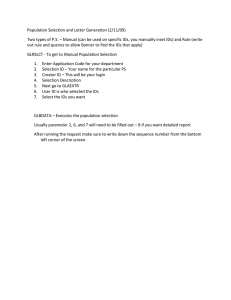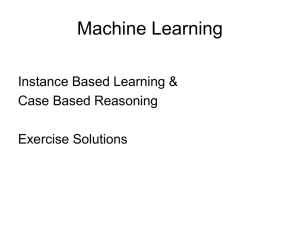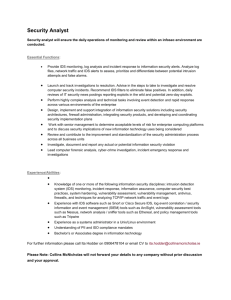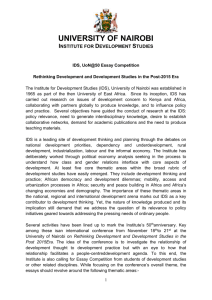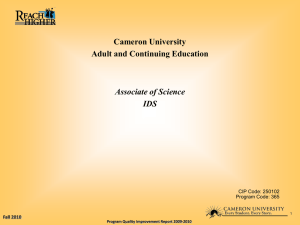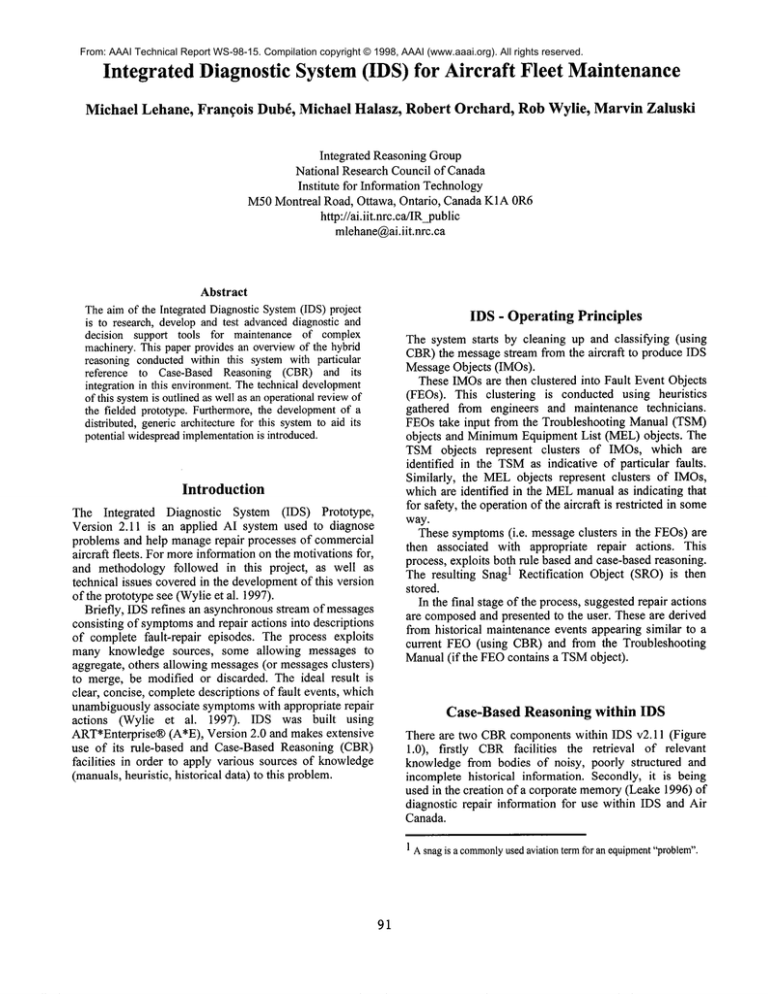
From: AAAI Technical Report WS-98-15. Compilation copyright © 1998, AAAI (www.aaai.org). All rights reserved.
Integrated Diagnostic System (IDS) for Aircraft Fleet Maintenance
Michael Lehane, Francois
Dub6, Michael Halasz,
Robert Orchard, Rob Wylie,
Marvin Zaluski
Integrated Reasoning Group
National Research Council of Canada
Institute for Information Technology
M50Montreal Road, Ottawa, Ontario, Canada K1A0R6
http://ai.iit.nrc.ca/IR_public
mlehane@ai.iit.nrc.ca
Abstract
The aimof the Integrated DiagnosticSystem(IDS)project
is to research, develop and test advanceddiagnostic and
decision support tools for maintenance of complex
machinery.This paper provides an overviewof the hybrid
reasoning conductedwithin this system with particular
reference to Case-Based Reasoning (CBR) and its
integration in this environment.Thetechnical development
of this systemis outlinedas well as an operationalreviewof
the fielded prototype. Furthermore,the developmentof a
distributed, genericarchitecture for this systemto aid its
potential widespreadimplementation
is introduced.
IDS - Operating Principles
Introduction
The Integrated Diagnostic System (IDS) Prototype,
Version 2.11 is an applied AI system used to diagnose
problems and help managerepair processes of commercial
aircraft fleets. For moreinformation on the motivationsfor,
and methodology followed in this project, as well as
technical issues covered in the developmentof this version
of the prototype see (Wylieet al. 1997).
Briefly, IDS refines an asynchronousstream of messages
consisting of symptomsand repair actions into descriptions
of complete fault-repair episodes. The process exploits
many knowledge sources, some allowing messages to
aggregate, others allowing messages(or messagesclusters)
to merge, be modified or discarded. The ideal result is
clear, concise, completedescriptions of fault events, which
unambiguouslyassociate symptomswith appropriate repair
actions (Wylie et al. 1997). IDS was built using
ART*Enterprise®(A’E), Version 2.0 and makes extensive
use of its rule-based and Case-Based Reasoning (CBR)
facilities in order to apply various sources of knowledge
(manuals,heuristic, historical data) to this problem.
The system starts by cleaning up and classifying (using
CBR)the messagestream from the aircraft to produce IDS
Message Objects (IMOs).
These IMOsare then clustered into Fault Event Objects
(FEOs). This clustering is conducted using heuristics
gathered from engineers and maintenance technicians.
FEOstake input from the Troubleshooting Manual (TSM)
objects and MinimumEquipment List (MEL)objects. The
TSMobjects represent clusters of IMOs, which are
identified in the TSMas indicative of particular faults.
Similarly, the MELobjects represent clusters of IMOs,
which are identified in the MEL
manual as indicating that
for safety, the operationof the aircraft is restricted in some
way.
These symptoms(i.e. messageclusters in the FEOs)are
then associated with appropriate repair actions. This
process, exploits both rule based and case-based reasoning.
The resulting Snag1 Rectification Object (SRO)is then
stored.
In the final stage of the process, suggestedrepair actions
are composedand presented to the user. These are derived
from historical maintenance events appearing similar to a
current FEO(using CBR)and from the Troubleshooting
Manual(if the FEOcontains a TSMobject).
Case-Based
Reasoning
within
IDS
There are two CBRcomponents within IDS v2.11 (Figure
1.0), firstly CBRfacilities the retrieval of relevant
knowledge from bodies of noisy, poorly structured and
incomplete historical information. Secondly, it is being
used in the creation of a corporate memory(Leake 1996)
diagnostic repair information for use within IDS and Air
Canada.
1 Asnagis a commonly
usedaviationtermfor an equipment
"problem".
91
Real
Ti: e--- -~
Messages
/
WRNMessage
t
FLR Message
Case-Base
Case-Base
Create IDS
Messages
(
/
Nuisance Rules
Case-Bases for Message Classification
F
F , SMe.age
L
(IMO’s) [’=
(O ff-line)
~
" ----lObjects
Identify Nuisance
Messages
)
T’shooting ManualI
....
Mini-mum- -]
Equipment
I
List (MEL) Rules I
L .....
]
T
~
.
I
l
TSM Rules
!
(
\
CreateTSM
0 bjects
/’
i~l-
+
\
Fault Event
Object (FEO) Rules ]
.~
/
[
\
~
MEL0 bjects
L
;
1
Aircraft Objects I
i /
FEO Objects
J
Ii J
\
)
_T
-.
~ Create/Update
"ISM Objects
[
~
Create MEL
0 bjects
Identify
fault ! :
parts/repair
’ actions from TSM /
,r
Display
\
Fleet Monitoring ~-~
Window
/
~+/
--
_+
Create and Store’\
Snag Rectification )
k\ (SRO) 0 bjects
/"
SRO Objects
i
(J ,den,ifyFan,,;
/
parts/repair actions)
from cases
.
Snag Case-Base
i
~
[’
Display Fault ’,
\ Resolution Window/
L
Aircraft
Monitioring
Window
( L:!Cas
\\:
Man~i:-il)-"-t
Window
....
Case-Base for Diagnostic Experience
Figure1.0 IDSV2.11Dataflow diagram.
Case-Bases for MessageClassification
TheAirbusA320aircraft on-boarddiagnostic routines
generatetwotypes of messages,namelyfailures (FLR)and
warnings(WRN)
messages.In total there are about3400
FLRand 560 WRN
cases representing these messages.
Messagesconsist of text and an ATAnumber;these
describethe aircraft components
in a hierarchicalmanner.
Messages
receivedfromthe aircraft cannotbe recognized
using simplystring matchingas they maybe distorted
duringtransmission.
Toovercome
this, twocase-bases
92
have been created for all the FLRand WRNmessages. As
messages are received the strings and ATAvalues are
matched using trigram matching against the appropriate
case-base and associate a unique identifier
with the
message object that is created. A threshold for matching
allows poor matches to be flagged. Occasionally, messages
are received that are not in the case-base; these are
investigated to see if this is a valid message that needs to
be added to the case base.
A*E’sCBRtools are being used here to provide the lowlevel inexact matching best described as an unusual,
implementation of an episodic memoryand one where it is
difficult to justify the use of the acronym"CBR"(Wylie
1998), (Watson 1997). While the use of a case-base
identify messages and assign unique identifiers is not a
standard use of CBRthis implementation has proven to be
robust in matching messages.
Case-Base for Diagnostic Experience
This case-base is usable as a corporate memoryallowing
retrieval of historical situations, whichappearsimilar to the
current situation, providing a meansby which maintenance
technical experts can feed their knowledgeback into line
maintenance system.
Presently, the case-base is managedthrough an off-line
facility
(the Snag Case Management Tool). This
application allows the user to browse the SROdatabase,
clean up the contents of an SRO,convert SROsinto cases,
test a new case against the existing case-base (for
redundancyand consistency) and add it to the case-base.
On-line, the snag case-base is searched each time a FEOis
selected by the user. If a case is found which has similar
symptoms(clusters of IMOs)then it is retrieved. Fromthe
retrieved cases, repair actions are extracted and used to
suggest courses of action to the user. The tight integration
of this type of CBRmechanism into a large hybrid
reasoning system, makes IDS interesting. At the moment,
effort is focused on precisely what diagnostic role the Snag
case-base should be playing in IDS, for exampleshould it
be refining diagnoses made using TSMknowledge or
should it be catching faults missed by the TSM. In
addition, how should the CBRsystem work from an
organizational perspective with respect to case creation and
validation policies (Kitano and Shimazu 1996) and what
impact does the CBRsystem have on communications
between the technical maintenance staff and the line
maintenancestaff?.
Evaluation
of IDS
The IDS v2.11 prototype has been on extended field trials
at Air Canadafor 9 months. This has lead to considerable
use of the prototype and generated valuable feedback.
During this time the prototype development has been
reviewed with the aim of assessing the execution of IDS
v2.11 and highlighting future research issues (Dub6
Wylie 1997). Technically, IDS v2.11 demonstrated that
hybrid AI reasoning systems are practical and can be built
using currently available tools, but development can
require a degree of customization to provide acceptable
results. The use of appropriate tools is critical in building
such applied AI systems. A*Ereduced the effort involved
in the development of IDS but because of the time
constrained, asynchronousnature of the system, it is not a
typical application of A’E, this stretched the envelope of
the development environment.
93
The developmentoflDS has confirmed the belief that to be
useful as a decision makingtool, systems must be closely
coupled to the organization’s underlying information
flows. A corollary to this is that developmenttools must
provide gooddata integration to existing applications.
Meanwhile,feedback from Air Canadahas indicated that
an "intelligent" application automatically collecting,
grouping and assessing sets of fault symptoms and
automatically alerting maintenance personnel is an asset.
The ability to automatically refer the user to the pertinent
maintenance manual pages to support the fault resolution
process is also extremelyuseful.
Overall,
recommendations
were for a system
incorporating more intelligence and one that integrated
with most of the information systems related to the
maintenanceoperation, this is one of the goals oflDS-98.
IDS-98:
A Distributed,
Generic Maintenance
Management System
The goal of IDS-98 is to create a new version of the IDS
software, which builds in an "evolutionary
way"
(McConnell1996) on the functionality of IDS v2.11, but
has a distributed architecture and reflects a generic
maintenance managementsystem that could be applied to
other application fields. In addition, IDS-98will constitute
a flexible infrastructure for integrated reasoning research
technical
including "operationalizing" of structured
documents, CBRand data mining (Wylie 1998).
Initial attempts at distributing IDS v2.11 involved
duplicating the asynchronousmessagefeeds as well as the
entire IDSapplication for each instance of the application.
This meant that each IDS application did the same
inferencing and database manipulation, this was not an
ideal solution for a systemthat will potentially be installed
across Air Canada’s maintenance operations. To overcome
this IDS-98 has a distributed architecture makinguse of
ActiveWeb® a Message-Oriented
Middleware (MOM)
product from Active Systems. MOM
refers to the process
of distributing data and control through the exchangeof
messages (Orchard 1997). ActiveWebdoes this defining
standard unit for capturing and exchanging information
called an "event". At the heart of the ActiveWebsystem is
a "broker" which handles the distribution of events. The
new architecture of IDS-98 presently consists of an IDS
v2.11 application connected via a Java® interface to an
ActiveWebbroker. Messagesfrom the aircraft are sent to
the IDS application where the inference is conducted and
then the resulting information is distributed to lightweight
remote Java applications.
This work is currently in
development, but the goal of IDS-98 is to adopt this
architecture, to which other modulesof the IDS-98system
will publish and subscribe to events.
Management/MTS),Colin Drennan, Henry Dungan, Gerry
Richardson (MTS), and Chris Sowerby (Propulsion
Engineering). From NRC: George Forester (Business
Development).
New Modules in IDS-98
The basic functionality of IDS-98will build on IDSv2.11
but will include several additions, integration of multiple
reasoning techniques, mobile implementation, extension to
other fleets, additional CBRfunctionality and a data
mining and trending module (L&ourneau, Matwin and
Famili 1998). From a CBRperspective the main focus will
be the enhancementof CBRfunctionality. This work will
initially focus on the two aspects of the current tool, firstly
user requirements and a task analysis exercise, and
secondly case attribute definition and representation. The
re-evaluation of the case attributes is in response to
suggestions from Air Canadathat a richer set of attributes
maybe neededfor case representation, this is a critical area
of CBRimplementation (Lehane 1997).
In addition, the functionality of the existing case base
managementtool will be enchanced by providing several
additional features. Presently, reoccurring symptomsets,
which lead to the creation of FEOs, are not highlighted,
within IDS-98 such FEOswill be highlighted graphically
within the case creation tool. This will allow the user to
track reoccurring problems more easily. The second
addition will allow case creators to assess the benefit of
adding cases to the case base. At the moment,before a case
is added to the case-base a user can check for redundancy
and consistency. An instrumentation module has been
developed which tracks the frequency of case retrieval
allowing an assessment of case usefulness. The integration
of this module within the case base managementtool
would allow evaluation of a new case against a historical
subset of data to checkfor instances of retrieval. It is also
intended that a version of this instrumentation will run in
the backgroundand track the frequency of case retrieval to
facilitate
evaluation of the case-base. The final
development component is the creation of a case-base
browser to allow viewing of stored cases.
References
Wylie, R., Orchard, R., Halasz, M., and Dubr, F. 1997.
IDS: Improving Aircraft
Fleet Maintenance. In
Proceedings of the Fourteenth National Conference on
Artificial Intelligence, 1078-1085. MenloPark, Calif.:
AmericanAssociationfor Artificial Intelligence.
Leake, D. B. (ed.) 1996. Case-Based Reasoning:
Experiences, Lessons & Future Directions. Cambridge,
MA:AAAIPress/MIT Press.
Wylie, R. 1998. Integrated Diagnostic System (IDS)
Strategic Review, Technical Report, Institute
for
Information Technology, National Research Council of
Canada.
Watson, I. 1997. Applying Case-Based Reasoning."
Techniques for Enterprise Systems. San Mateo, Calif.:
Morgan KaufmannPublishers.
Kitano, H., and Shimazu, H. 1996. The Experience-Sharing
Architecture: A Case Study in Corporate-WideCase-Based
Software Quality Control. In Case-Based Reasoning:
Experiences, Lessons &Future Directions, 235-268, edited
by D. B. Leake. Cambridge, MA:AAAIPress/MIT Press.
Dubr, F., and Wylie, R. 1997. Integrated Diagnostic
System (IDS) Prototype Evaluation Report, Technical
Report, Institute for Information Technology, National
Research Council of Canada.
McConnell, S. 1996. Rapid Development: Taming Wild
Software Schedules. Microsoft Press.
Conclusions
Orchard, R. 1997. Distributed
Computing: Current
Directions - The MiddlewareExplosion, Technical Report,
Institute for Information Technology, National Research
Council of Canada.
The development of IDS has demonstrated both the
importance and viability of an integrated decision making
system for the maintenance of complex fleets such as
aircraft. The evolution of IDS from v2.11, through to IDS98 underlines the intent within the Integrated Reasoning
group to continue this developmentin an evolutionary way
adding technical functionality that provides measurable
utility and advances the use of integrated hybrid reasoning
systems.
L6toumeau, S., Matwin, S. and Famili, F. 1998. A
Normalization Method for Conceptual Data: Experience
From a Large-Scale Application. Forthcoming in the
Proceedings of the Tenth European Conference on
Machine Learning.
Lehane, M. S. 1997. The use of Case-BasedReasoning for
Decision Support in Engineering Design. Ph.D. diss., Dept.
of Civil Engineering, Cardiff University, Wales, UK.
Acknowledgements
Manypeople are involvedin this project, but special thanks
go to the following for their continued support. FromAir
Canada: Robert Ferland, Robert Parker, Dave Clarke,
Marie-Jo Leconte (IDS Production Team), Joe Mallory
(Information
Technology),
Ron
Blue
(Fleet
94
Appendix
A: Case-Based
Integration
Reasoning
1. Integration name/category: Integrated Diagnostic
System (IDS). There are two CBRcomponents within this
system, Case-Bases for Message Classification & CaseBase for Diagnostic Experience.
2. Performance Task: Case-Bases
for Message
Classification - Retrieval and classification of messagesto
control system input. Case-Basefor Diagnostic Experience
- Retrieval for past experiential knowledgeto aid decisionmaking.
3. Integration Objective: The objective of this system was
to create an integrated solution, whichclosely aligned itself
to the existing organizational information flows. The CaseBase for Diagnostic Experience provides feedback and
learning within an otherwise continuous stream of
messages, which are classified
by the two message
classification case-bases.
4. Reasoning Components: Rule Base Reasoning (RBR)
and CBR.
5. Control Architecture: Sequential, system architecture
is built around the information flow, which uses both RBR
and CBR.
6. CBRCycle Step(s) Supported: Case-Bases for
MessageClassification - Pre-processing and Retrieval.
Case-Base for Diagnostic Experience - Retrieval, Reuse,
Revision and Retention.
7. Representations: Cases and rules are used extensively
within the system.
8. Additional Reasoning Components:User Interaction
for case creation and addition to case-base of diagnostic
experience.
9. Integration Status: Applied.
10. Priority future work: Development of additional
functionality and on-going system evaluation in applied
environment.
95


